“Weekends” Warrior | Introducing “Weekends with Yankee”
Food editor Amy Traverso searches out delicious dining in our new WGBH television series, Weekends with Yankee. Plus four featured recipes.
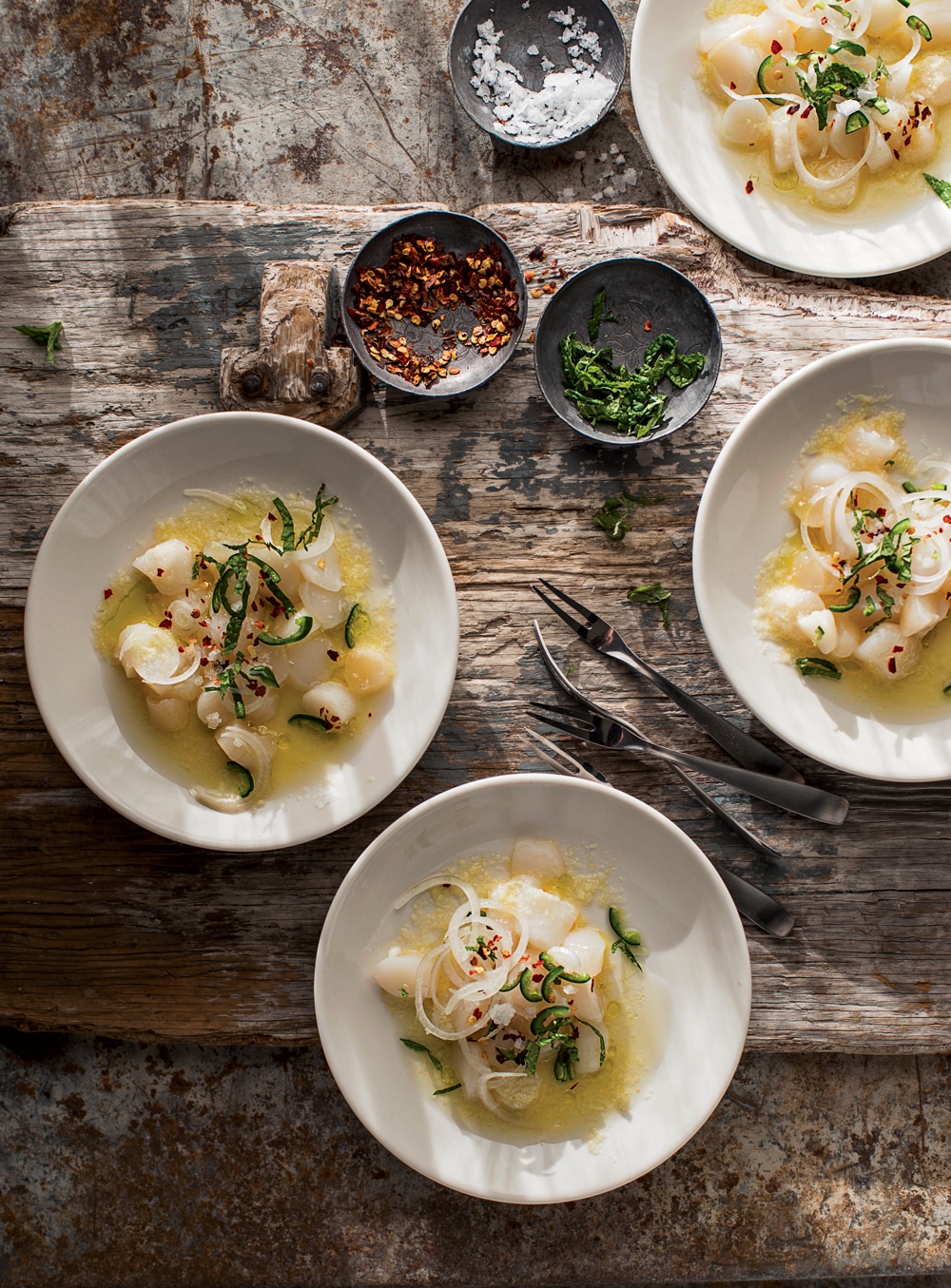
Coffee By Design | Portland, Maine
Photo Credit : Katherine KeenanOn Martha’s Vineyard, a late October cold snap strips away any illusions that the modulating Gulf Stream breezes will keep winter at bay forever. One week it’s roses and a last trip to the beach; the next week it’s frost. The gingerbread cottages at the Martha’s Vineyard Camp Meeting Association are mostly closed up now, as are the Oak Bluffs arcade and the Flying Horses Carousel that so recently thrummed with vacationing children. Circuit Avenue is eerily quiet, though Linda Jean’s is still serving up breakfast sandwiches and morning gossip for the real residents, the ones who stick around even after the winds turn bitter and damp.

Photo Credit : courtesy of WGBH
I am here with the last of the tourists to capture these final beautiful days for our new public television series with WGBH, Weekends with Yankee (debuting in April, 2017; check local listings). It’s not quite dawn, and looking out my hotel window I see a thin line of orange light cracking the horizon over Nantucket Sound. A cold wind is whistling around the window frame, and I’m thinking I should’ve packed warmer socks.
Down in the lobby, I grab a Linda Jean’s sandwich from WGBH associate producer Adrienne Rahn, who has made a 6:30 run to pick up breakfast for our small crew. Call time is 7, and we sip coffee and wonder how chilly it will be on the water. At about 7:30 we’ll board the 36-foot fishing boat Payback, out of Edgartown Harbor, to dredge sweet bay scallops from Cape Poge Bay. I’ll be cooking on the boat—or at least prepping raw scallops with citrus and chilies, in the style of an Italian crudo. So despite the poor sleep and thin socks, I’m buzzing. It’s another day of adventure, another day of making television.
Down at the Edgartown docks, we wait. This, I’m learning, is how TV works. We wait for the director, Rennik Soholt, to pre-interview the boat’s captain (Rennik wants us to meet him for the first time on-camera, so that it feels more authentic). We wait for Alan Weeks, the director of cinematography, to adjust his camera settings every time a cloud passes over the sun or to reset a shot from a different angle. It’s fine. We are filming in the most beautiful places in New England, destinations we mapped out over many months with the idea that the series would bring viewers the best of the best. It’s as if we’ve jumped into the pages of Yankee itself. And Richard Wiese, the show’s host—you may know him from his other show, PBS’s Born to Explore—helps pass time by telling stories of hiking Kilimanjaro at age 11, of skiing to the North Pole, of living among Batwa pygmies in Uganda. I’m the food correspondent, so I’m filming just one segment per show, but he’s always there, ready to share a tip (“Once the camera starts rolling, don’t forget to take five steps before you start talking,” he reminds me—multiple times—yet I still forget).
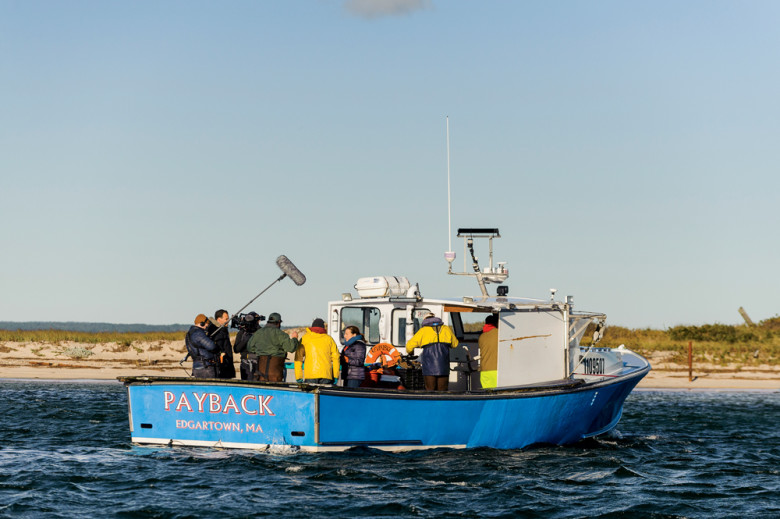
Photo Credit : Mark Fleming

Photo Credit : courtesy of WGBH
Rennik signals that it’s time to board the boat. Already my feet are cold. The blood from my better-insulated upper half flows down to my feet, drops 10 degrees, then heads back up. Captain Donny Benefit hands me a rubber coat, plus gloves, to layer over my down jackets, but it’s a whole other world among the 4-foot swells. And so, a new challenge: speaking with a steady voice when my body is convulsing with cold. The hair I so carefully styled at 6 a.m. is now a swirling rat’s nest at war with an elastic band. Still, this is heaven. Captain shows us how he drops his chain nets down to the bay floor, where they rake over the eelgrass beds where scallops thrive, leaving the grass mostly intact. Rick Karney, a shellfish biologist and director of the Martha’s Vineyard Shellfish Group, explains how his team seeds these beds with young spats, which can take up to a year to reach maturity. And when we haul up our first net full of sea life—crabs, whelks, clams, and a few scallops—he points out which ones are too small to harvest. We toss them back into the water.
After several runs—delayed by the need to move the crew to the harbormaster’s boat for a wide shot, to get the right interviews, to find the fertile beds—we have enough mature scallops to start shucking. Captain easily cracks open the shells and yanks out the viscera with a quick flip of a knife blade, leaving the cream-colored knob of adductor muscle to slice out and eat; I pop one into my mouth and taste a creamy sweetness that underscores why bay scallops are called “nature’s gumdrops.” With about 40 shucked scallops in hand, I duck into the heated wheelhouse and carve a work space out of a 2-foot shelf. The waves make it difficult to slice evenly, and I have to brace one leg against a bench to stay upright. But I manage to juice two oranges and a lemon, grate some ginger, and arrange the scallops on a plate with the citrus sauce, a little oil, and a sprinkling of chilies, mint, slivered shallots, and sea salt. As crudo should be, the dish is a play on contrasting flavors and textures: hot and cold, silky and crunchy, sweet and sour. The heat from the chilies feels like sunshine. The guys gobble it up—all except Captain, who doesn’t eat scallops raw. Instead, he sets some aside to fry up on a single burner.
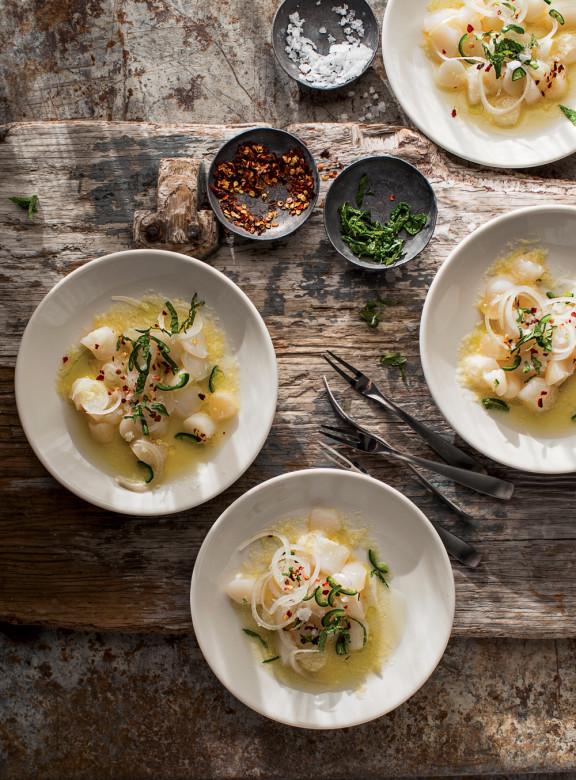
Photo Credit : Mark Fleming
Food consumed, we turn around and make our way through the narrow Cape Poge Gut as the tide begins to ebb. Captain has another job to head out to that afternoon, and he’s already given us more time than he had to spare. Back on land, we remove our layers, marveling at all the heat reflecting off the sidewalk, a sensation we wouldn’t have noticed before. “It was a warm day,” Rick assures me. “This is just the beginning of the season.” I wouldn’t dare contradict him. Nor will I ever complain about the price of bay scallops again.
It is the great privilege of journalists to be able to enter the world of a stranger, even live in it for a day or two. Making Weekends with Yankee is a similar experience, only compressed into a high-octane joyride: Today it’s scalloping; tomorrow it might be making cheese in Vermont, baking clams in a remote cove on Mount Desert Island, or cooking on a windjammer in Rockland Harbor. I’m a New England native and have worked at Yankee for nearly 10 years. I’ve covered the region from so many angles, but in making this series I’ve fallen in love with it all over again. If we’ve done our job right, you will too.
The following recipes are just a sampling of the delicious dishes that we prepared on-camera while filming Weekends with Yankee. For more information, visit the show’s website at weekendswithyankee.com.
ADDITIONAL RECIPES
JEREMY SEWALL’S OYSTER STEW
I came by my next seafood feast with far less feigned machismo: While Richard boarded a boat in the early morning with Jay Baker of Fat Dog Shellfish, an oyster farm in New Hampshire’s Great Bay, I slept in (there wasn’t room on the boat, alas). Around midmorning, we met up at Row 34, the Granite State outpost of the popular Boston oyster bar, where we prepared a fresh take on oyster stew with chef-owner Jeremy Sewall.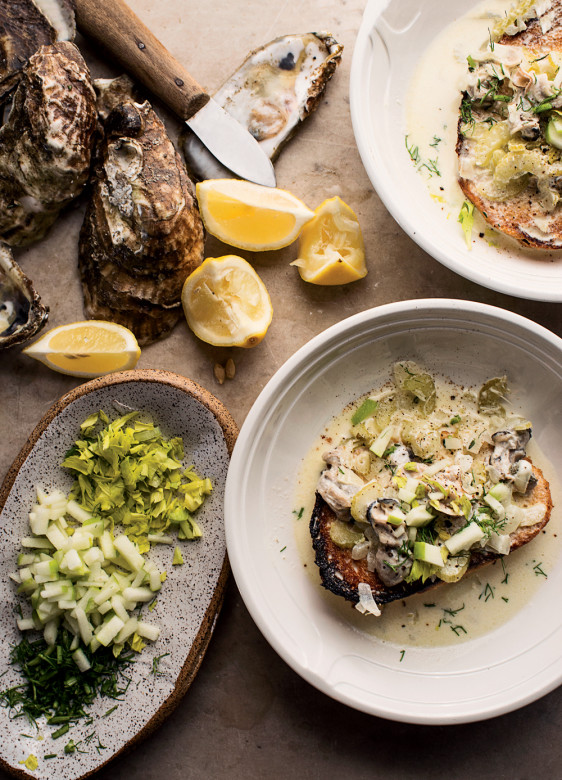
Photo Credit : Mark Fleming
While I’ll admit I’m a serious apple lover—I wrote a book on the subject—it never once occurred to me to combine apples and oysters. But Jeremy used diced apples as a garnish to delicious effect, adding fennel, thyme, celery, and onion as complementary notes. When he served up the stew in wide-rimmed bowls over toasted sourdough bread, I savored every bite, despite the total absence of suffering.
ALLISON HOOPER’S SQUASH AND GOAT CHEESE GALETTE
Allison Hooper is well known among New Englanders who love great cheese and butter. Her company, Vermont Creamery, produces more than 4 million pounds of fresh and aged cheeses, crème fraîche, butter, and other dairy products. You may also recognize her from the pages of Yankee: Our May/June 2016 issue told the story of Allison and her business partner, Bob Reese, and their newest venture, a model farm called Ayers Brook Goat Dairy, where they work to develop healthier goat breeds and best practices. The goal? To produce milk for the creamery and offer Vermont dairy farmers struggling with the volatile milk commodity market a sustainable alternative to raising cows.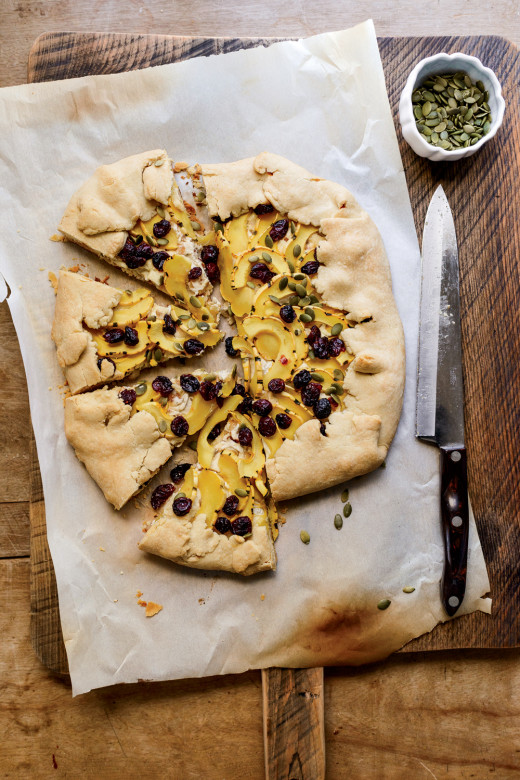
Photo Credit : Mark Fleming

Photo Credit : Heath Robbins
When we visited Allison, we began the day at Ayers Brook, where we were greeted by a herd of 500 beguiling Saanens, LaManchas, and Alpines, then headed north to tour Vermont Creamery’s 14,000-square-foot cheese-making facility in Websterville. Donning hair nets and sanitation suits, we moved from one atmosphere-controlled room to the next, each calibrated to optimize milk culturing, curd development, and cheese ripening. Finally, we decamped to Allison’s hillside farm in nearby Brookfield—home to the original milk house where the company began more than 30 years ago—to make a delicious savory tart with her own products. We cooked together and shared stories. It was dark by the time we pulled the sweet-savory tart from the oven, a cozy fall evening enriched with a deeper understanding of what farm-to-table really means.
EVENTIDE OYSTER’S BROWN-BUTTER LOBSTER ROLL
One of our most dramatic days of shooting happened in Acadia National Park on a lesser-known strip of the northern coast, between Eastern Bay and Frenchman Bay. We set up a traditional beachside clambake among the rock formations known as the Ovens, which are accessible only at low tide and mostly only by kayak. There is no public parking in this corner of the park, but we were guests of Andrew Taylor, whose family has a house here and who, with partners Arlin Smith and Mike Wiley, owns two of Maine’s most acclaimed restaurants, Eventide Oyster and Hugo’s, both in Portland.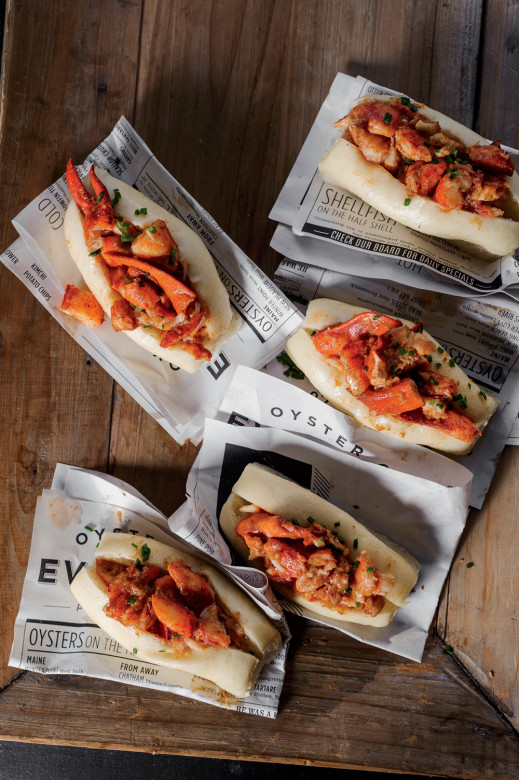
Photo Credit : Mark Fleming
The Ovens are geological marvels, caves carved out of weaker rock exposed to eroding tides. For our clambake we assembled lobster, potatoes, clams, salt pork, a few eggs (tradition has them acting as a sort of timer for the lobster meat), and Red Snapper hot dogs (a Maine delicacy), building a fire on the beach and cooking the food, layered in seaweed and burlap, on a large steel tray Andrew had fabricated for just this purpose. Time was of the essence, as the tide was heading in while the lobsters were cooking. The rocky ground would soon be under-water, and all we could do was wait.
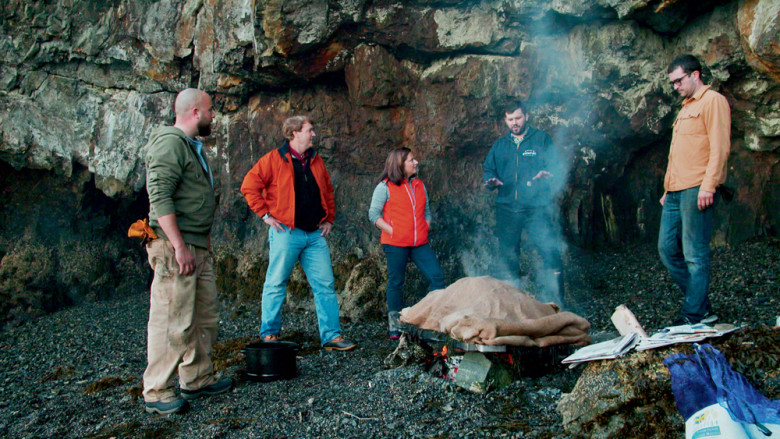
Photo Credit : courtesy of WGBH

Photo Credit : courtesy of WGBH
Having spent their adult lives in the compressed heat of restaurant kitchens, Andrew, Arlin, and Mike aren’t inclined to break a sweat—but as the water inched up toward the glowing coals and the seaweed steamed under its burlap cover, they began to fidget. Finally, Andrew called it. They pulled the heavy tray off the fire and carried it over some rocks to higher ground. As they returned to finish cleaning up, a wave washed over the still-hot coals, sending a 12-foot plume of steam into the midday air.
Ravenous, we picked at the food with our bare hands, dipping lobster meat into a rich brown butter sauce that the Eventide team makes by cooking powdered milk with unsalted butter until it takes on a walnut hue. This butter is the base of Eventide’s signature lobster roll, a departure from Maine tradition served on a Chinese-style steamed bun. We’ve adapted their recipe to serve on regular New England hot dog buns, but that addictive butter is well worth a try.
Learn more about Weekends with Yankee, including the latest station information, here.







I am a new resident in New England. Do you have a chronological listing of the dates, times, and broadcasting stations for the Weekend With Yankee? I live in Northampton, MA
Please send me the dates times and channel for weekends with Yankee thank you